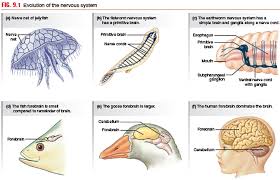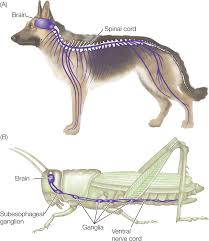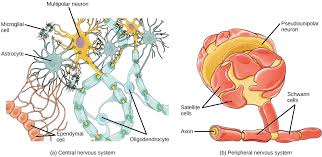
The nervous system is an organ system consisting of a network of specialized cells called neurons that coordinate the actions of animals and transmit signals between different parts of the body.
In most animals, the nervous system is divided into two main parts: the central nervous system (CNS) and the peripheral nervous system (PNS). The central nervous system of vertebrates, such as humans, contains the brain, spinal cord, and retina.
The peripheral nervous system is made up of sensory neurons, clusters of neurons called ganglia, and nerves that connect them to each other and to the central nervous system. These regions are interconnected by complex neural pathways.
The enteric nervous system, a subsystem of the peripheral nervous system, has the capacity to function independently in controlling the gastrointestinal system, even when severed from the rest of the nervous system through its primary connection by the vagus nerve.
Neurons send signals to other cells in the form of electrochemical waves traveling along thin fibers called axons. These signals cause neurotransmitters to be released at junctions known as synapses.
A cell that receives a synaptic signal may be excited, inhibited, or otherwise modulated. Sensory neurons are activated by physical stimuli, such as light or sound, and send signals that inform the central nervous system about the state of the body and the external environment.
Motor neurons, located either in the central nervous system or in peripheral ganglia, connect the nervous system to muscles or other effector organs. Central neurons, which in vertebrates significantly outnumber the other types, make all their input and output connections with other neurons.
The interactions of these neurons form neural circuits that generate an organism’s perception of the world and determine its behavior. Along with neurons, the nervous system contains other specialized cells called glial cells (or glia), which provide structural and metabolic support.
Read Also: The Benefits of Crop Dusting
The Diversity of Nervous Systems Across Animal Species

Nervous systems are found in most multicellular animals, but their complexity varies greatly. Sponges, for example, have no nervous system, although they have homologs of many genes that play crucial roles in nervous system function.
They are capable of several whole-body responses, including a primitive form of locomotion. Placozoans and mesozoans, simple animals that are not classified as part of the subkingdom Eumetazoa, also lack a nervous system.
In radially symmetric animals, such as jellyfish, the nervous system consists of a simple nerve net. Bilateral animals, which include most vertebrates and invertebrates, have a nervous system containing a brain, one central cord (or two running in parallel), and peripheral nerves.
The size of the bilaterian nervous system can range from a few hundred cells in the simplest worms to approximately 100 billion cells in humans. Neuroscience is the study of the nervous system.
Structure of the Nervous System
The nervous system derives its name from nerves, which are cylindrical bundles of fibers that emanate from the brain and central cord, branching repeatedly to innervate every part of the body.
Nerves were large enough to be recognized by ancient civilizations such as the Egyptians, Greeks, and Romans, but their internal structure was not understood until the advent of the microscope.
Microscopic examination reveals that nerves primarily consist of the axons of neurons, along with various membranes that wrap around them and segregate them into fascicles. Neurons that give rise to nerves do not lie entirely within the nerves themselves their cell bodies are located within the brain, central cord, or peripheral ganglia.
The Evolution of Nervous Systems in Animals

All animals more advanced than sponges have nervous systems. However, even sponges, unicellular animals, and non-animals, such as slime molds, have cell-to-cell signaling mechanisms that are precursors to those of neurons.
In radially symmetric animals, such as jellyfish and hydra, the nervous system consists of a diffuse network of isolated cells. In bilaterian animals, which make up the great majority of existing species, the nervous system has a common structure that originated early in the Cambrian period, over 500 million years ago.
Cell Types in the Nervous System
The nervous system is primarily composed of two categories of cells: neurons and glial cells.
1. Neurons in the Nervous System
Neurons, also known as nerve cells, define the nervous system. Neurons are distinguished by their ability to communicate with other cells via synapses, which are membrane-to-membrane junctions that facilitate the rapid transmission of signals, either electrical or chemical.
Many neurons possess an axon, a protrusion that can extend to distant parts of the body and make thousands of synaptic contacts. Axons often travel in bundles called nerves.
In the nervous system of species like humans, there are hundreds of different types of neurons with a wide variety of morphologies and functions.
These include sensory neurons that transduce physical stimuli, such as light and sound, into neural signals, and motor neurons that convert neural signals into the activation of muscles or glands.
However, in many species, the majority of neurons receive all their input from other neurons and send their output to other neurons.
2. Glial Cells and Their Functions in the Nervous System
Glial cells are non-neuronal cells that provide support and nutrition, maintain homeostasis, form myelin, and participate in signal transmission within the nervous system.
In the human brain, it is estimated that the total number of glial cells roughly equals the number of neurons, though the proportions vary in different brain regions.
Among the most important functions of glial cells are supporting neurons and holding them in place, supplying nutrients to neurons, insulating neurons electrically, destroying pathogens, removing dead neurons, and providing guidance cues to direct the axons of neurons toward their targets.
A very important type of glial cell oligodendrocytes in the central nervous system and Schwann cells in the peripheral nervous system generates layers of a fatty substance called myelin. This myelin wraps around axons and provides electrical insulation, enabling them to transmit action potentials much more rapidly and efficiently.
Read Also: Growing and Care Guide of Cotton Plants
Functions of the Nervous System

At its most basic level, the function of the nervous system is to send signals from one cell to another, or from one part of the body to another. There are various ways in which a cell can send signals to other cells. One method involves releasing chemicals called hormones into the internal circulation, allowing them to diffuse to distant sites.
In contrast, the nervous system provides “point-to-point” signals neurons project their axons to specific target areas and make synaptic connections with specific target cells. Thus, neural signaling offers a much higher level of specificity compared to hormonal signaling. It is also much faster, with the fastest nerve signals traveling at speeds exceeding 100 meters per second.
On a more integrative level, the primary function of the nervous system is to control the body. It achieves this by extracting information from the environment using sensory receptors, sending signals that encode this information to the central nervous system, processing the information to determine an appropriate response, and then sending output signals to muscles or glands to activate the response.
The evolution of a complex nervous system has enabled various animal species to develop advanced perceptual abilities, such as vision, complex social interactions, rapid coordination of organ systems, and integrated processing of concurrent signals.
In humans, the sophistication of the nervous system enables features such as language, abstract representation of concepts, the transmission of culture, and many other aspects of human society that would not be possible without the human brain.
Neurons and Synapses in Signal Transmission
Most neurons send signals via their axons, although some types are capable of dendrite-to-dendrite communication. (In fact, the types of neurons called amacrine cells have no axons and communicate exclusively via their dendrites.).
Neural signals propagate along an axon in the form of electrochemical waves called action potentials. These action potentials produce cell-to-cell signals at points where axon terminals make synaptic contact with other cells.
Synapses may be electrical or chemical. Electrical synapses establish direct electrical connections between neurons, while chemical synapses are much more common and diverse in function.
In a chemical synapse, the cell that sends signals is termed the presynaptic cell, and the cell that receives signals is termed the postsynaptic cell. Both the presynaptic and postsynaptic areas are filled with molecular machinery that facilitates the signaling process.
The presynaptic area contains numerous tiny spherical vessels called synaptic vesicles, which are packed with neurotransmitter chemicals. When the presynaptic terminal is electrically stimulated, molecular mechanisms in the membrane are activated, causing the release of neurotransmitters into the narrow space between the presynaptic and postsynaptic membranes, known as the synaptic cleft.
The neurotransmitter then binds to receptors embedded in the postsynaptic membrane, triggering an activated state. Depending on the receptor type, the resulting effect on the postsynaptic cell may be excitatory, inhibitory, or modulatory.
For example, the release of the neurotransmitter acetylcholine at a synapse between a motor neuron and a muscle cell induces rapid muscle contraction. The entire synaptic transmission process takes only a fraction of a millisecond, although the effects on the postsynaptic cell may persist much longer, even indefinitely in cases where the synaptic signal leads to the formation of a memory trace.
Anatomy in Vertebrates
The nervous system in vertebrate animals (including humans) is divided into two main parts: the central nervous system (CNS) and the peripheral nervous system (PNS). The CNS is composed of the brain and spinal cord, while the PNS includes all the nerves that lie outside the CNS.
1. Central Nervous System (CNS)
The CNS is the largest part of the nervous system and consists of the brain, located in the head, and the spinal cord, housed within the spinal cavity. The brain is protected by the skull, while the spinal cord is protected by the vertebrae.
Surrounding the brain and spinal cord are protective membranes called meninges, composed of three layers, with the tough outer layer known as the dura mater. The CNS plays a central role in processing sensory information and generating responses.
2. Peripheral Nervous System (PNS)
The PNS comprises the nerves that extend beyond the CNS. It is responsible for transmitting signals between the CNS and the rest of the body. The PNS is divided into two main parts: the somatic nervous system, which controls voluntary movements of muscles and receives sensory information, and the autonomic nervous system, which regulates involuntary functions such as heart rate and digestion.
The autonomic nervous system is further divided into the sympathetic and parasympathetic systems, which have opposite effects on bodily functions.
3. Grey and White Matter
The nervous system contains two types of tissue: grey matter and white matter. Grey matter contains a high concentration of neuron cell bodies and is found in the brain’s outer layers and parts of the spinal cord. White matter consists mainly of myelinated axons that connect different parts of the nervous system, giving it a whitish appearance. The myelin helps in faster transmission of electrical signals.
Comparative Anatomy and Evolution of the Nervous System
In the evolutionary context, animals exhibit various forms of nervous systems. For instance, sponges, which lack true neurons, have cells that communicate via calcium waves. In more complex animals like jellyfish, a nerve net is present, consisting of diffuse sensory, motor, and intermediate neurons.
Bilateria and Nervous System Layout
Most animals belong to a group called bilaterians, which have a body plan that includes a central nerve cord and a segmented nervous system. In vertebrates, the nerve cord is positioned dorsally, while in invertebrate protostomes, the nerve cord is ventral.
This distinction highlights the evolutionary divergence between these groups. Vertebrates also possess an enlarged nerve ganglion at the front of the body, which forms the brain.
Nervous System of Worms and Arthropods
Worms, such as earthworms, possess a simple nervous system with two nerve cords running along the length of their bodies. Arthropods like insects have a more complex system consisting of ganglia connected by ventral nerve cords. Their nervous systems control various functions, including sensory processing and motor responses.
In certain simpler organisms, such as the roundworm Caenorhabditis elegans, every neuron is identifiable and has a unique set of properties. In vertebrates, only a few neurons, such as the Mauthner cells in fish, are considered identified neurons. These cells play a crucial role in escape responses, demonstrating the specialized functions of identified neurons in certain species.
Do you have any questions, suggestions, or contributions? If so, please feel free to use the comment box below to share your thoughts. We also encourage you to kindly share this information with others who might benefit from it. Since we can’t reach everyone at once, we truly appreciate your help in spreading the word. Thank you so much for your support and for sharing!
Read Also: Cod Liver Oil Capsules: All You Need to Know About





